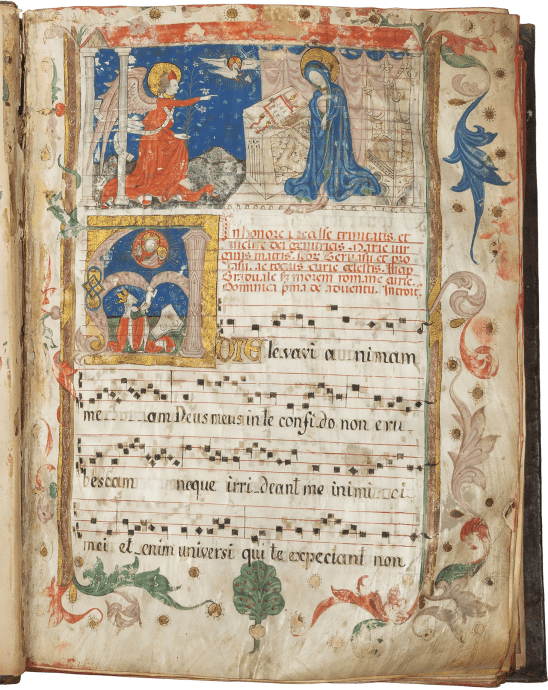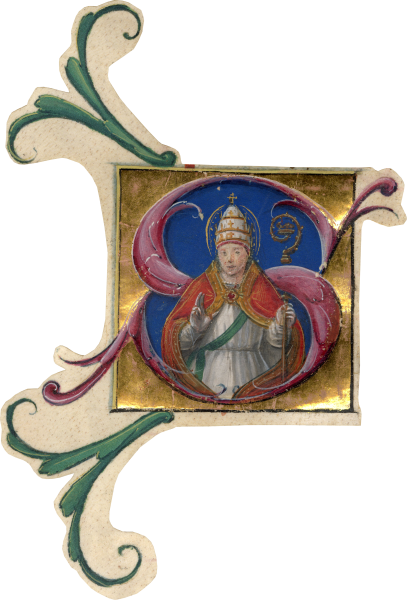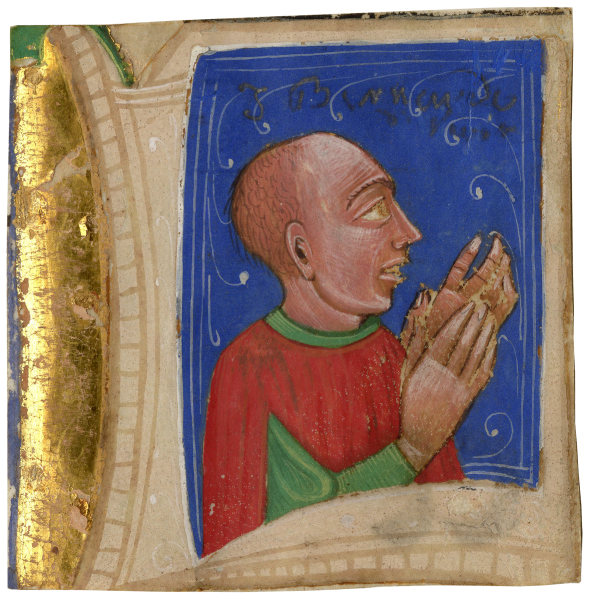


Choir Gradual with feasts for the Temporal (Franciscan Use)
, Piedmont, Northern Italy, c. 1450-1460







Choir Gradual with feasts for the Temporal (Franciscan Use)
Description
192 folios on parchment, original foliation in red Arabic numerals middle outer margin on the verso, leaving the last two folios numbered and with errors as follows: 1-67,*69, 70-105, *108, 109-116, 116 bis, 117-132, 132 bis, 133-188, 187 bis, 188 bis, 189-191, complete (collation i-xiii8 xiv4 xv2 xvi-xxiv8 xxv10), catchwords center lower margins, no signature, rule with the horizontal lines in ink, and double vertical bounding lines in hardpoint, (justification 372-370 x 245-240 mm.), written in a skilled rounded gothic book hand with eight lines of text and eight lines of music on each page, square musical notation on four-line red staves, red rubrics, majuscules touched with yellow, majuscules following painted initials often with delicate infilling and scrolling in pen, red folio numbers, one-line pen initials alternating red and blue with pen decoration in the opposite color, numerous (at least 95) painted foliate initials, equivalent to one line of text and music (c. 75 x 55 mm.), light purple, green, or blue with white modelling infilled with lush green, orange, yellow acanthus leaves or flowers, on grounds of yellow (brushed gold?) or blue, grounds sometimes follow the shape of the initials slightly, edged in black, some with colored acanthus leave extending from the corners of the initials, ELEVEN HISTORIATED INITIALS equivalent to one- to two-lines of text and music and ONE MINIATURE WITH A FULL BORDER(described below), in sturdy condition, but with numerous signs of use through the centuries, numerous faded pages where the ink has likely powdered away (text remains legible), most noticeably on ff. 3, 7, 29, 33, 41, 53, 56v, 61, 57, 86, 97v 113v 120v 129v 139v 152 179v, a later seventeenth- or eighteenth-century had has rewritten faded sections of text, as for example on ff. 2, 31, 49, 50v, 54v, 55, 62v, 63, 74, 90, 100, 105, 108, 109v, 110, 114, 121, 143, 148, tear on the lower margin of ff. 4, 73, 89 (with early sewing), 108 (repaired with a parchment patch), ff. 28, 186, 187, repairs lower margin, f. 188 several tears and a large repair, thumbing in lower margins, first quire partially detached at the toop. Bound in 17th- or 18th-century brown leather over wooden boards, edges dyed red (occasionally extending into the margins of some folios), Dimensions 480 x 355 mm.
Bifolium, four pages (early modern pagination, 255-256, 269-270) of an unrelated thirteenth-century Gradual laid in, written in a northern Gothic bookhand with six lines text and music, (justification 305 x 210 mm.), square musical notation on red 4-line staves, 2-line pen initials in red and blue, Dimensions 435 x 320 mm.
It is not always the case that we can associate a manuscript so closely with the circumstances of a particular site. Thanks to new research, this one must have been made in Piedmont for the Franciscans in Domodossola during the very period when the cathedral there was being rebuilt, and the Franciscan church was serving as its replacement. Choir Books are among the most celebrated illuminated manuscripts from Italy in the Middle Ages and Renaissance. Our Gradual, of significant historical interest, survives here in its entirety with its illuminated initials intact. The artist, an interesting provincial follower of an important Northern Italian illuminator, testifies to the spread of mainstream Lombard styles of illumination past mid-century.
Provenance
1. Based on the evidence of the text, script, and the style of the illumination, we conclude this was copied and illuminated in Piedmont, Northern Italy c. 1450-1460, almost certainly for the Franciscans of Domodossola in the diocese of Novara (we thank Dr. Gaudenz Freuler for sharing his expertise). The Litany for the Easter Vigil Mass found on f. 123v is very brief, so the inclusion of two bishops of Novara, Saints Gaudentius and Agabius, is significant. The same litany also includes Saints Francis, Anthony, and Clare, the main saints of the Franciscan order, evidence, along with details of the text (e.g., “fratres” are mentioned in the rubrics), that this was made for Franciscan friars. The text begins with a rubric stating that the volume was dedicated to the Holy Trinity, the Virgin Mary, and Saints Gervasius and Protasius. Sts. Gervasius and Protasius were patron saints of Domodossola in the Piedmont at the foot of the Italian Alps, and the cathedral of Domodossola was dedicated to them.
At the time our Gradual was made, the cathedral of Domodossola was destroyed for strategic reasons. The Visconti, who enlarged the fortress of Domodossola and the city walls, wanted to destroy the Cathedral because of its location near the walls, and promised to finance the building of a new cathedral in its current location in the city, just opposite the Franciscan church. The earlier cathedral was destroyed c. 1450, and construction of the new cathedral began. The building process was a prolonged one (and not, as promised, financed by the Visconti). Masses were not held in the new cathedral until 1470, and it was not consecrated until 1476. In the decades while the new cathedral was being built, the church of the Franciscan convent served in its place. Therefore, our Gradual, which was likely commissioned c. 1450, when the building of the new cathedral began, served both the Franciscans and the parishioners of Domodossola, who heard mass in the Franciscan church while they were deprived of their cathedral. When the new cathedral was ready, our manuscript may have remained at the Franciscan convent, or it may have been used at the new cathedral.
2. The addition of chants for the Mass of the Transfiguration, added at the end in a later hand in the sixteenth or seventeenth century might also support, in a very indirect manner, a date before 1457 when this feast was adopted by the Franciscans (and the whole Church). The Transfiguration, however, is a feast included in the Sanctoral. It is possible, but of course far from certain, that it was copied here because a companion volume to this one lacked the feast.
3. In active liturgical use for centuries; in addition to general signs of wear, numerous faded pages were rewritten in the seventeenth or eighteenth century (see above); there are also a few later additions, for example f. 5v.
4. Private USA Collection.
Text
ff. 1-187v, In honore <precelse?> trinitatis et inclite dei genitricis marie uirginis matris sanctorum geruasii et protasii ac tocius curie celestis. Incipit Graduale secundum morem romane curie, Dominica prima de aduentu …; Temporal from the first Sunday in Advent to the 24th Sunday after Pentecost;
Includes sometimes lengthy liturgical directions at appropriate points in the text from the Franciscan Ordinal; to choose one for example, the liturgy for Palm Sunday which begins on f. 92v, with the blessing of Palms and the procession on f. 93v, describing the distribution of the Palms to the brothers (… Postea duo fratres ramos fratribus in locus suis manentibus distribuit …), the exit from the church, and the return to the church (cf. Van Dijk, 1963, vol. 2, pp. 234-235). The Litany for the Easter Vigil Mass on f. 123v includes Gregory, Martin, Francis, Anthony, Gaudentius, bishop of Novara, and Agabius, bishop of Novara as the six confessors, and Agnes, Agatha, and Clare as the three Virgins.
ff. 187v-191, Settings for the Kyrie, Gloria, Adoramus te, Sanctus, and Agnus dei for Sundays and duplex feasts, followed by “Asperges me domine,” and “Vidi aquam egrediente”; [ff. 190-191, Mass for the Transfiguration added later (16th or 17th century), incipit, “Viderunt ingressus tuos deus ingressus regis me …”; [f. 191v, blank].
Illustration
The program of illustration includes a full-page frontispiece, eleven historiated initials before major feasts, and numerous painted initials introducing almost all the remaining masses. The painted initials are all light purple/mauve on gold grounds (now cracking and not highly polished), with very lush and heavy acanthus leaves extending from the initials; each scene is set against a deep blue background, strewn with clusters of small white dots.
Subjects as follows:
f. 1, Full-page frontispiece, with a miniature (135 x 245 mm.) of the Annunciation at the top, above a large historiated initial (110 x 90 mm.), of King David, kneeling, and offering his soul (a small infant), to God. Page framed on the inside and out with bar borders, sprouting lush acanthus leaves, which form a full border around the page (rubbing to border, gold cracking in the initial, with some patches lost, a few patches of color in the Annunciation lost especially at the top of the miniature);
f. 14 (Christmas), Nativity, showing only the Christ child with donkeys;
f. 15v, (Christmas, Mass at dawn), Christ child on a green hill with a starry sky (possibly retouched);
f. 16v, (Christmas, main Mass), Nativity with Mary Joseph and the Christ child, larger miniature, equivalent to two lines of text and music, with acanthus extending full length of the written space (gold cracking);
f. 18v, St. Stephen;
f. 20, St. John the Evangelist (larger initial equivalent to two lines of text and music);
f. 24v, (Epiphany), Adoration of the Magi;
f. 126, (Easter), Resurrection of Christ (larger initial equivalent to two lines of text and music);
f. 141v, Ascension of Christ (Ascension);
f. 145v, Pentecost;
f. 154v, (Corpus Christi), Monstrance.
There are also two elaborate and humorous grotesques in the place of ‘I’s: f. 26, a hybrid man- dragon; and f. 109v, a dragon or a griffon.
The miniatures are very attractive and likely were painted by a provincial artist interpreting models created by refined Lombard illuminators from the middle of the fifteenth century, in particular, the Master of the Budapest Antiphoner, (fl. c. 1444-c. 1450) (we thank Dr. Gaudenz Freuler for the attribution). This master is named after an Antiphonal in the Library of the National Museum in Budapest (Orságos Széchényi Könyvtár, c.l.m.ae. 462). His work is characterized by fluid lines, complex spatial compositions, fine facial details, high foreheads, and a color scheme where quiet colors contrast with strong backgrounds and bright foliage. Our provincial artist favored mauve for the initials and seems not to have had access to bright red but does use a bright orange and a very deep strong blue for his backgrounds. His faces are less nuanced, but the high foreheads are noticeable. The cutting in the Fitzwilliam Museum, Cambridge, by the Budapest Master (Online Resources), possibly from a missing leaf of the Budapest manuscript, depicts King David kneeling in prayer to a vision of God in the sky. The initial of King David on f. 1 of our manuscript is a close comparison in terms of composition; David is dressed in orange and green with similar crowns in both miniatures. Our artist’s image, however, is stiffer, and lacks the fluidity of the Budapest Master’s composition.
Other influences on our artist’s work include the related Master of the Franciscan Breviary (active 1440-1460), named after Bologna, Biblioteca Universitaria, Bologna, MS 337, whose career and style overlap with those of the Budapest Master. Certain decorative devices such as the bar borders on f. 1 may follows examples by earlier artists active in Lombardy, including Michelino da Besozzo (Michelino de Mulinari) (Italian, Lombardy, active 1388–1450), and also the later works of Cristoforo Cortese (c. 1399-1455).
The Gradual is the liturgical book which contains the musical texts for the Mass arranged according to the liturgical year. During the Mass in the later Middle Ages, the priest used the Missal, whereas the cantors and the choir used the Gradual. The texts here are all from the liturgical cycle known as the Temporal (Sundays and feasts celebrating the life of Christ, dependent on the movable feast of Easter). A second companion volume would have been on hand including the Sanctoral (fixed feasts of the saints and Virgin Mary), and the Common of Saints.
Large-format liturgical books such as this one were used in the late Middle Ages to enable groups of priests or monks to sing from a single manuscript, a practice amply documented by miniatures of such groups in manuscripts of the period. These manuscripts often remained in use for several centuries, as was the case here. The extensive fading seen on the flesh side of the parchment of many leaves in our Antiphonal is not uncommon in Italian manuscripts (the carbon-based ink used in Italy and the high polish of the parchment sometimes created an environment where the ink flaked or powered off the page). It is interesting to see many of these faded leaves rewritten in the early modern period, probably in the seventeenth or eighteenth century, testifying to the long use of this volume. It is also possible that some of these leaves were deliberately erased and then later rewritten at this later date in order to incorporate revisions to the liturgy, a point that is worth investigating further.
The Franciscan order begins with St. Francis of Assisi, whose followers were granted permission to live his radical vision of a life of complete apostolic poverty by Pope Innocent III in 1210. The Franciscan Order grew rapidly, attracting members across Europe. Since they were an international order, the need for a uniform liturgy was felt from an early point in their history, and the Rule of 1223 specified that the Friars were to follow the Office “according to the order of the Roman Church” (Van Dijk, 1963). This “order of the Roman Church,” actually the liturgy used at the Papal Court, became the basis for the Franciscan liturgy. Franciscan Use, or Use of Rome, seen in our Antiphonal, was destined to have a great influence on the subsequent history of the Roman liturgy, since it was the basis for the liturgy eventually mandated by the Council of Trent to be used throughout the Roman Catholic Church.
Literature
Boehm, Barbara Drake. Choirs of Angels: Painting in Italian Choir Books, 1300-1500, New York 2009.
Harper, J. The Forms and Orders of Western Liturgy from the Tenth to the Eighteenth Century: A Historical Introduction and Guide for Students and Musicians, Oxford, 1991.
Hiley, David. Western Plain Chant. A Handbook, Oxford, 1993.
Moorman, John. A History of the Franciscan Order from its Origin to the Year 1517, Oxford, 1968.
Palazzo, Eric. A History of Liturgical Books from the Beginning to the Thirteenth Century, tr. by Madeline Beaumont, Collegeville, Minnesota, 1998.
Plummer, J. Liturgical Manuscripts for the Mass and Divine Office, New York, Pierpont Morgan Library, 1964.
Van Dijk, S. J. P., ed. Sources of the Modern Roman Liturgy: The Ordinals of Haymo of Faversham and Related Documents, 1243-1307, Leiden, 1963.
Online Resources
Susan Boynton, Consuelo Dutschke, et al. “Liturgical Books” (Columbia University Libraries)
https://liturgical.columbia.edu/
Lebigue, J.-B. “Initiation to Liturgical Manuscripts”
https://cel.archives-ouvertes.fr/cel-00194063/document
Detailed record for Additional 18197, f. M, Lombardy, c. 1450-1460 (Master of the Budapest Antiphonal)
https://www.bl.uk/catalogues/illuminatedmanuscripts/record.asp?MSID=19013&CollID=27&NStart=18197
Detailed record for Additional 71119F
https://www.bl.uk/catalogues/illuminatedmanuscripts/record.asp?MSID=18962&CollID=27&NStart=71119
London, Victoria and Albert, Cutting by the Master of the Budapest Antiphoner (or the related, Master of the Franciscan Breviary), Northern Italy, c. 1450, 4928 (MS 1166, Accession number 4928
https://collections.vam.ac.uk/item/O120003/manuscript-cutting-master-of-the/
Cambridge, Fitzwilliam Museum, Initial from a Choir Psalter by the Master of the Budapest Antiphonal, Marlay cutting It. 17
https://collection.beta.fitz.ms/id/object/176541

